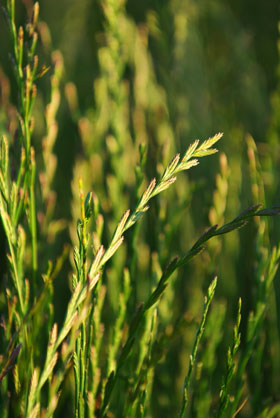General Information
Types of Oregon-grown Ryegrass:
Fine-bladed Turf-type Perennials
Elite, dark green varieties sold by brand name. Found on home lawns, athletic fields, golf course greens and fairways. (A blend of three turf-type ryegrasses has been used in the Super Bowl for many years.) Widely used to winterseed dormant winter turf in the southern United States.
Oregon-grown common Annual and Gulf Annual Ryegrass
"Utility" grasses for temporary turf where quality is not paramount. Popular for winterseeding dormant home lawns, parks, playgrounds and athletic fields in the southern U.S. Have broader blades and are a brighter green than the turf-type perennials.
Linn Perennial Ryegrass
Relatively broad-bladed and bright green grass, is also a "utility grass" normally sown where color and quality are not paramount.
Uses of Oregon-grown Ryegrass
- Home lawns
- To stabilize soil
- Athletic fields
- Winterseeding dormant turf in subtropic, southern "Bermudagrass" regions
- Golf courses
- Parks and playgrounds
- Permanent turf in northern regions
- Environmental Advantages
- Reduces need for pesticides to control weeds and unwanted vegetation
- A healthy 50' x 50' lawn produces enough oxygen for a family of four
- Requires less water for germination and maintenance during winter months
- Helps reduce surface temperatures as opposed to asphalt or concrete
Adaptability
Tolerates a wide range of soil types including poor soils such as clay or compacted, badly drained areas
- Prefers medium-to-good fertility and reasonably good surface drainage
Germination
7 to 10 days is normal, even less under optimum conditions
Cold Tolerance
At their best in regions where winter temperatures do not stay in the 25-35° F range for extended periods
Heat Tolerance
Slightly less able than the fine fescues and Colonial and creeping bentgrasses to survive continued day and nighttime summer temperatures in excess of 85-90°F for extended periods.
Mowing Heights
Home lawns - 1-1/2 inches
Golf course greens - 3/16 inch
Golf course tees and fairways - 1 inch or less
Fertilization
- Home lawns - apply a balanced "slow release" fertilizer at rates suggested on package or by sales people in both spring and fall
- Best pH range for Ryegrass is 6.5, but it will do well in a range of 5.5 to 8.5
Shade Tolerance
- Prefers full to medium sun
- Ranks with Kentucky bluegrass in its ability to prosper in shade
- When in full or part shade, should be mowed at a height of approximately two inches
Mixing with Other Grasses
- A bunch grass, ryegrass does not creep and is often mixed with fine fescues and Kentucky bluegrass to form superior turf
